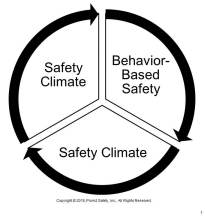Climate and Culture Before, Not After, Behavior-Based Safety
For BBS to work, the organization must have a culture ready for the tool to take them to the next level.
Safety culture is not the next step after Behavior-Based Safety (BBS) efforts; it's a determining factor on whether to implement or not implement a behavioral approach. Because culture is the most effective reinforcement tool, it will be one of the most important considerations when attempting to implement either compliance or advanced behavioral efforts.
One client recently shared, "We unknowingly decided to provide the workforce of a site we recently acquired new steel-toed boots, as we knew they wouldn’t have the resources or channels to procure them. It was, after all, a company-wide safety policy, and we knew many employees didn’t currently wear shoes in the community from which they came. We found out shortly afterwards that most employees promptly sold them to friends and family for extra money."
If it is not common to wear protective shoes to work, like within some cultures, mandating new foot protection will be met with minimal compliance. While it's an extreme example, your culture is often why improvement efforts, compliance or advanced, succeed or fail.
Recently, there has been a push by some within the BBS community to attempt to differentiate by promoting the next evolutionary step to BBS as a focus on safety culture or to create a culture where there is observable and heart-felt caring. This is concerning and might provide insight into why the typical pre-packaged or pre-defined BBS methodologies never yield the expected return. When it comes to change, especially with culture, one size never fits all.
Evolving a culture is like growing a plant. You can't manage culture, nor can you manage the growth of a seed. It is the climate and chemistry that must be managed to obtain the desired outcome. Culture is what is common within an organization, group, or society. Further, it is an outcome, a byproduct. You can't manage a result.

If the culture is not already made up of leaders and at least some workers committed to safety excellence, BBS won't work. If the culture does not have a caring atmosphere, BBS won't work. If cooperation doesn't already exist within the culture, BBS won't work. If coaching is not common and viewed as a desirable, expected, and reinforced interaction and communication style, BBS won't work. If the safety climate or chemistry is not ripe for a new seed of change (i.e., BBS) to be grown, always start with the climate and chemistry.
Knowing what it takes to achieve excellence in safety culture, BBS was never designed to be a direct culture-changing tool. Certainly, it had some positive carryover effect. However, it was designed to address and improve behaviors that could help prevent injuries and incidents. Once this gains traction and it (e.g., observations, feedback, peer-to-peer safety communication, and leveraging proactive safety measurements to improve safety) becomes common, it becomes cultural, which is a byproduct of the efforts.
To say the next step after BBS is to directly address the safety culture or create an environment where caring is more common is akin to a car manufacturer deciding to enter the flight or float industries to capture additional market share with its existing knowledge, technologies, manufacturing, and assembly plants. Eventually there might be a way to make this work, but there are also much better, more effective, and efficient tools to accomplish the same result. Moreover, entering into a market to serve customers with what you think they will want or need without knowing what they value and what they would accept or reject is fraught with opportunities for disaster.
For BBS to work, the organization must be ready for the approach, both in traditional aspects of their safety management-systems and compliance efforts, but also by having a culture ready for the tool to take them to the next level. Implementing any significant improvement approach prior to understanding and addressing the cultural considerations is, quite simply, horrible, unwise, and unethical advice. What people will support and not support must always be a considered factor.
This article originally appeared in the July 2015 issue of Occupational Health & Safety.